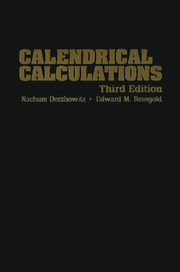Book contents
- Frontmatter
- Dedication
- Contents
- List of Frontispieces
- List of Figures
- List of Tables
- Abbreviations
- Mathematical Notations
- Preface
- Credits
- License and Limited Warranty and Remedy
- About the Cover
- 1 Calendar Basics
- I ARITHMETICAL CALENDARS
- 2 The Gregorian Calendar
- 3 The Julian Calendar
- 4 The Coptic and Ethiopic Calendars
- 5 The ISO Calendar
- 6 The Islamic Calendar
- 7 The Hebrew Calendar
- 8 The Ecclesiastical Calendars
- 9 The Old Hindu Calendars
- 10 The Mayan Calendars
- 11 The Balinese Pawukon Calendar
- 12 Generic Cyclical Calendars
- II ASTRONOMICAL CALENDARS
- III APPENDICES
- Index
- Envoi
- About the Cover
8 - The Ecclesiastical Calendars
Published online by Cambridge University Press: 05 February 2014
- Frontmatter
- Dedication
- Contents
- List of Frontispieces
- List of Figures
- List of Tables
- Abbreviations
- Mathematical Notations
- Preface
- Credits
- License and Limited Warranty and Remedy
- About the Cover
- 1 Calendar Basics
- I ARITHMETICAL CALENDARS
- 2 The Gregorian Calendar
- 3 The Julian Calendar
- 4 The Coptic and Ethiopic Calendars
- 5 The ISO Calendar
- 6 The Islamic Calendar
- 7 The Hebrew Calendar
- 8 The Ecclesiastical Calendars
- 9 The Old Hindu Calendars
- 10 The Mayan Calendars
- 11 The Balinese Pawukon Calendar
- 12 Generic Cyclical Calendars
- II ASTRONOMICAL CALENDARS
- III APPENDICES
- Index
- Envoi
- About the Cover
Summary
We send you the good news concerning the unanimous consent of all in reference to the celebration of the most solemn feast of Easter, for this difference also has been made up by the assistance of your prayers, so that all the brethren in the East, who formerly celebrated this festival at the same time as the Jews, will in future conform to the Romans and to us and to all who have from of old kept Easter with us.
—Synodal Letter of the Council of Nicæa to the Church of Alexandria (325 C.E.)The calculation of the date of Easter has a fascinating history, and algorithms and computer programs abound (for example, [1], [2], [9], [10], [13], and [14]). Many of the computations rely on the formulas of Gauss [5], [6] (see also [8]). Our fixed-date approach allows considerable simplification of “classical” algorithms.
The history of the establishment of the date of Easter is long and complex; good discussions can be found in [3] and [7]. The Council of Nicsa convened in 325 C.E. by Constantine the Great, was concerned with uniformity across various Christian groups. At the time of Nicæa, almost everyone in the official Church agreed to the definition that Easter was the first Sunday after the first full moon occurring on or after the vernal equinox [3] (a rule promulgated by Dionysius Exiguus and the Venerable Bede, who attributed it to the Council of Nicæa).
- Type
- Chapter
- Information
- Calendrical Calculations , pp. 113 - 122Publisher: Cambridge University PressPrint publication year: 2007



